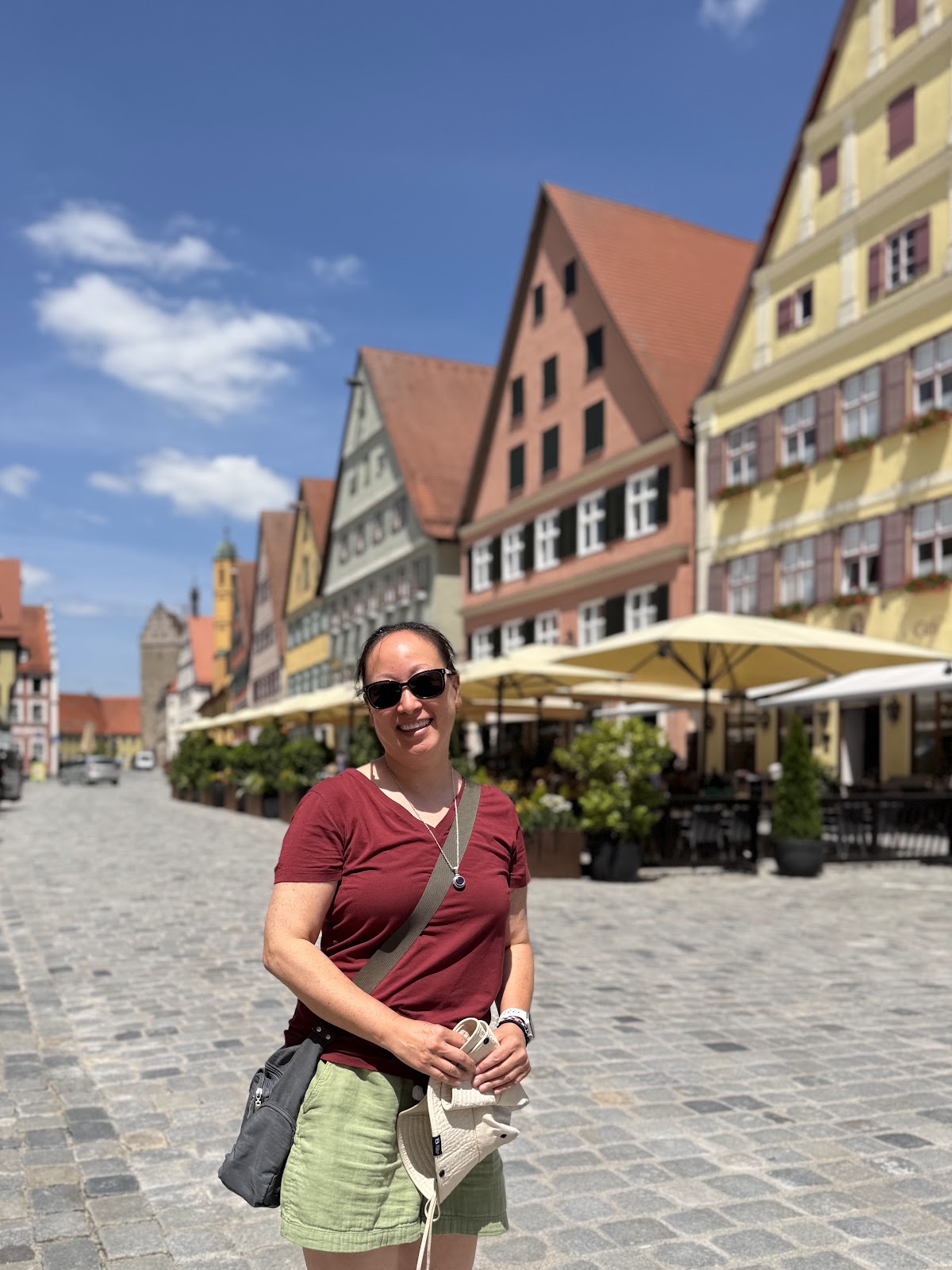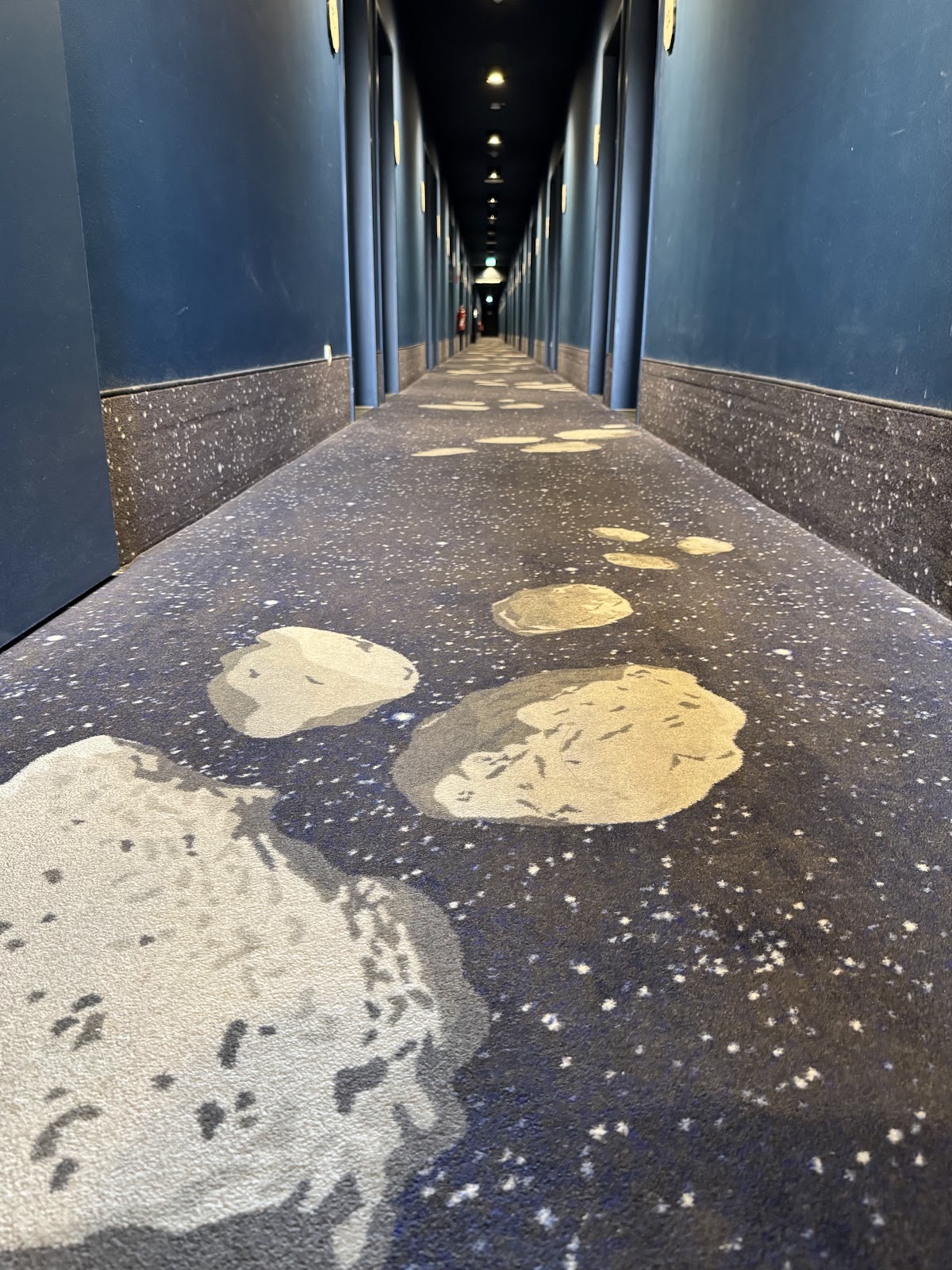MONDAY, June 16 - Bamberg
This morning, I joined the taxi ride with Sarah, Kyle, and Irene to the Berlin Airport to get my rental car. It was an easy pickup, and smooth sailing on the Autobahn for the 4 hour drive to Bamberg.
The UNESCO World Heritage Site of Bamberg is a well-preserved medieval town with hundreds of half-timber houses. Timbered structures are created through a traditional building method using carefully joined heavy beams (that carry the structural load), with a non-load bearing infill between the beam. When the timbers are exposed as decoration on the outside of the building, it’s referred to as half-timbered. Known as Fachwerk in German, this is a popular building method dating back to the 14th century.
 |
| Bamberg's Altes Rathaus |
Bamberg was founded in the early 900s (and was the site of hundreds of witch trials in the 17th century!) It is known for its Altes Rathaus, or Old Town Hall, which is built on a little island over the Regnitz River. Part of the building is painted with a gorgeous baroque fresco, and the other is half-timbered in white and yellow.
Most people visit Bamberg because it is famous for smoked beer (and there is a very popular brewery trail including over 70 breweries in the town and surrounding area!), but since I’m not a beer drinker, I just wandered around enjoying the narrow, winding cobblestone streets and charming, flower-adorned houses. Also lining the riverbanks is a colorful row of fisherman’s houses known as “Little Venice”.
 |
| Little Venice, on the banks of the Regnitz River |
TUESDAY, June 17 - Rothenburg ob der Tauber and Dinkelsbühl
 |
| Rödergasse and the Marksturm tower |
Rothenburg ob der Tauber is one of the key stops on the famous Romantic Road (Romantische Straße), the themed route through southern Germany that highlights several fairytale towns, castles, and scenic views. Founded around 970, Rothenberg was a prosperous market town until its economy declined after the Thirty Years’ War. But this lack of development helped preserve the town’s medieval architecture, and the rise of tourism in the 19th century helped revive Rothenburg. It was partially bombed during WWII, but was reconstructed and is now one of the most photographed places in Germany.
* * * * * * * * * * * * * * * * * * * * * * * * * * * *
Brief History Break – The Thirty Years’ War
One of the most destructive wars in European History, the Thirty Years’ War (1618 - 1648) occurred in central Europe because of conflicts between Catholics and Protestants, political rivalries, and struggles for dynastic control. Religious tensions started a century before with the Protestant Reformation (1517), and the Peace of Augsburg (1555) which allowed rulers to choose their state’s religion. But when Protestant nobles in Bohemia rebelled against their Catholic king and threw royal officials out the window (The Defenestration of Prague), it triggered a revolt that sparked the start of the war. During the 30-year course of conflict, between 4 to 8 million people died from battle, famine, and disease (in some regions of Germany a third of the population died), and the economy was devastated. The Peace of Westphalia (1648) that ended the war is thought of as the birth of modern diplomacy.
Protestant Rothenburg was captured by Catholic forces in 1631 during the Thirty Year's War by General Johann Tilly, who intended to punish the town for resisting by destroying it. The town council, in desperation, offered General Tilly a massive tankard (about 1 gallon) of Franconian wine. Tilly then counter-offered, saying if one of the councilmen could drink the entire tankard in one try, he would spare the town. The heroic (?) Georg Nusch stepped up, and to everyone's amazement, drank the whole thing in one long gulp - and so Rothenburg was spared from destruction.
* * * * * * * * * * * * * * * * * * * * * * * * * * * *
 |
| Marktplatz |
 |
Gerlachschmiede, the former blacksmith's house,
as seen from the city wall |
I spent the morning wandering, particularly around the marktplatz and up on the wall that encircles the old town. Rothenburg is thought of as the quintessential fairy-tale town, so much so that Walt Disney used it as inspiration for the visual design of Pinocchio's town. And I can attest - it really does feel like walking around a movie set.
 |
| Plönlein, the corner that inspired Walt Disney |
 |
| Trying schneeballen. Meh. |
Rothenburg is also known for its Schneeballen ("Snowballs"), deep fried dough covered in chocolate or sugar. Of course I had to try some! (Spoiler alert: not great. It was kind of tasteless and stale, but fresh and covered in cinnamon sugar.)
 |
| Views from the Burggarten |
The full name of the town, Rothenburg ob der Tauber, means "Red Fortress over the Tauber" and indeed the town sits on the edge of a valley carved by the Tauber River. Just outside the city wall is the Burggarten, the gardens of the former castle that was mysteriously destroyed by a supposed "earthquake" in the 14th century (but one that didn't touch any other building in town).
 |
| Tauberbrücke, the Double Bridge |
Down on the Tauber, a double bridge built in the 1300s crosses the river. Although it looks like a Roman aqueduct, it is actually just a bridge built on top of an original bridge that was too short.
 |
| I had soup, but no wine on the Weinmarkt |
Less than an hour south of Rothenburg is the quaint medieval city of Dinkelsbühl. It became an official town around 1130 and, like Rothenburg, thrived as a market and trading center. It was also threatened during the Thirty Years' War - Swedish troops captured the town, but local children begged the commander to spare them and the commander, a sucker for the kids, agreed. Unlike Rothenburg, Dinkelsbühl survived WWII unscathed and so it is one of the best-preserved medieval towns with an intact city wall.
 |
| The gabled houses of Dinkelsbühl |
The best activity in a town like Dinkelsbühl is to just get lost wandering aimlessly, and I spent my time doing just that. Unlike most towns of the time, there is no central marketplace; instead, different streets were reserved for trade in different markets - the bread market, pig market, cattle market, etc. I had lunch (a lovely asparagus soup) on the Weinmarkt, which boasts the most charming and delightful colored gable houses.
There were little surprises found in random places, like the little model house stuck on the side of its larger prototype, or the nests of storks on top of the red-roofed buildings. In a word, Dinkelsbühl was enchanting.
 |
| The mural depicts the children of the town begging for mercy during the Thirty Years' War. And storks were nesting everywhere! |
WEDNESDAY, June 18 - Nördlingen & Wies
 |
| The hallway of my hotel |
Nördlingen is the last of the three medieval towns on the Romantic Road with intact city walls. What makes it stand out was only discovered in 1960 - that the circular depression the town lies in is actually an impact crater, formed by a massive meteor that crashed into Earth over 14 million years ago. The Nördlingen crater is actually the only rampart crater (a crater with fluidized ejecta - ie like mud) on Earth - the only other known rampart craters are on Mars. Additionally, the meteor impacted a nearby graphite deposit, creating millions of teeny tiny diamonds (less than 0.2mm across) that scattered into the local stone. This is the same stone that was quarried to build the town's buildings... scientists estimate 72 million kilograms of diamonds are in the area, so the town is basically made of diamonds!
 |
| Marktplatz and Tanzhaus |
 |
| Kriegerbrunnen (Warrior Fountain) & the St. Georgskirche |
Nördlingen was first established as a free imperial city in 1215. The Battle of Nördlingen in 1634 was a major battle of the Thirty Years' War, when the Swedish/German army was totally crushed by the Imperial Spanish Army. Luckily, it was spared during WWII and so it retained near-original conditions.
 |
| The wide open 'moat' that is the rim of the Ries Crater |
I enjoyed walking part of the city wall, which sits just inside what feels like a grassy moat surrounding the city (but is the rim of the crater). Nördlingen isn't as touristy as the other two walled cities, and it definitely feels grittier and more lived in. Nonetheless, an interesting visit!
In 1738 in the town of Wies, a dilapidated wooden sculpture of Jesus miraculously began to shed tears. An influx of pilgrims began flocking in to see it, and it soon became clear the tiny chapel that they'd built in 1740 wasn't big enough for all the visitors. The local abbey decided to build a 'glorious rococo jewel' in 1743, and today over a million people visit the Pilgrimage Church of Wies, or Wieskirche, each year.
 |
| The open fields around Wieskirche |
The church sits alone in a large open meadow at the foot of the Bavarian Alps, a fairly simple building that belies what is hidden inside. It's a pleasant stroll through the bucolic countryside to get to the church... and then you step inside, and it's complete sensory overload. When I first walked in, the organ was playing, the rich and resonating music filling the church.
Tons of light pours in from large windows and bounces off brilliant white walls, highlighting the elaborate frescoes that adorn the trompe l'oeil ceiling. The large domed ceiling appears to open up into a sunshine-and-rainbows sky, filled with angels and a smiling Jesus. At the front of the church is an elaborate altar housing the famed crying Scourged Savior statue.
Was it over the top? Undoubtedly yes. But it was totally worth the visit.






















No comments:
Post a Comment